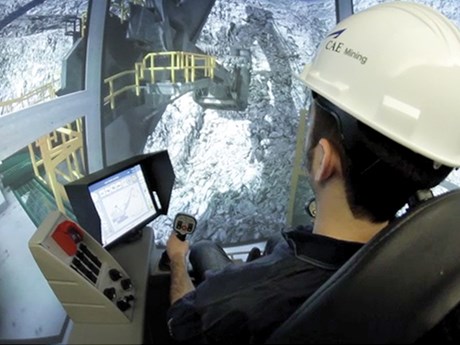CAE Mining, a subsidiary of CAE Inc., the global leader in simulation and training for the civil aviation and defence industries, will introduce its first simulator for the mining industry at MINExpo 2012 in Las Vegas, September 24 to 26.
The mining and aviation industries have a lot in common, said Pascal Grenier, CAE Mining’s director of engineering. Safety is paramount in both industries and, whether it’s a 747 or an 11-yard loader operating in a narrow drift underground, the operator has to be highly skilled.
Grenier estimates that only 20 per cent of equipment operators in the mining industry are currently trained on simulators, but CAE Mining believes that’s going to change.
“There’s a big demand for resources now and there’s also a skill shortage, so training will become more and more important,” he predicted.
There are several reasons mining companies should be training their operators on simulators, said Grenier. Conventional training behind the wheel of a multi-million dollar machine can be time consuming, expensive and dangerous. Furthermore, the skill of an operator has a huge impact on productivity and the life expectancy of the equipment.
“Wear and tear on a piece of equipment can drive up costs substantially if it isn’t being operated properly,” he said.
There’s an impact on consumables like brake pads and tires, and when a vehicle is in the shop, it’s not moving muck.
CAE offers two types of simulators. One is a classroom environment designed for multiple trainees, the other is a container that can be located at a mine site and moved to different locations.
“We believe a proper training environment is extremely important,” said Grenier. “When training an operator, you have to brief the person before introducing him to the simulator and debrief him afterwards. Doing this in a proper classroom environment in a building improves retention.
“Briefing and debriefing capability is still possible in a container, but you’re limited by the number of people who can be accommodated at the same time.”
To date, CAE Mining has manufactured simulators for a 793F Caterpillar haul truck and a P&H 4100 electric shovel. However, the company also expects to develop simulators for loaders, jumbos, dozers and graders.
Simulators are designed for a specific piece of equipment, explained Grenier.
“It’s the same with flight simulators. If you’re flying a 737, you expect the pilot to be trained on a 737. The pilot (or operator) has to feel like he’s in a real life environment and forget that it’s a simulator.
“We supply simulators to Boeing and Airbus. When they develop a new aircraft, they come to us for the simulator.”
It takes CAE six months to manufacture a simulator for a specific piece of equipment with a replica of the OEM’s cabin and all of the switches, buttons and gauges in the exact position.
Training should not be a one-time event, according to Grenier.
Operators should be trained on a recurring basis using information on actual performance and targeted lessons to drive continuous improvement, he advises.
Training can be delivered using generic mine layouts, or layouts replicating a specific mine based on aerial photography and mine plan drawings.
Trainees are exposed to various scenarios, said Grenier. For example, we can tell the simulator you’re operating a shovel with five trucks, it’s foggy and raining, and there’s a pickup truck in the vicinity.
The trainee sits in front of a circular screen and has a 180-degree field of view. A seamless image produced by three projectors simulates the mine environment, whether open pit or underground. The trainee even feels the equipment vibration and motion as it moves or digs into a muckpile.
Montreal-based CAE Inc. made its first foray into the mining industry in 2010 with the acquisition of Datamine, a U.K. based company with a broad suite of software products for geological data management, resource and reserve management, ore evaluation, mine design and scheduling, and mine production.
It subsequently acquired Century Systems, a Sudbury company specializing in geological data management systems for core logging, quality assurance and quality control.
While engineering for the company’s mining simulators is done in Montreal, CAE’s Sudbury office is the company’s centre of mining expertise for Canada and has responsibility for simulator sales.



